#with this i can make comics in painterly style that would be too time consuming otherwise
Text
NEUROSLUG NEUROSLUG NEUROSLUG
Ahem.
So, I spent the last day force-feeding Stable Diffusion my art to teach it the concept of an anthropomorphic insect. As a result, I have a working LoRA that imitates my coloring style fairly decently and it can kinda do bug anthros. Emphasis on "kinda", it still needs a lot of iterations to be able to maintain proportions on it's own. However, it does quite great when provided with a simple line drawing as a quideline.
Here are some examples I whipped up in like 2 hours.
Input image:

AI's pure output:
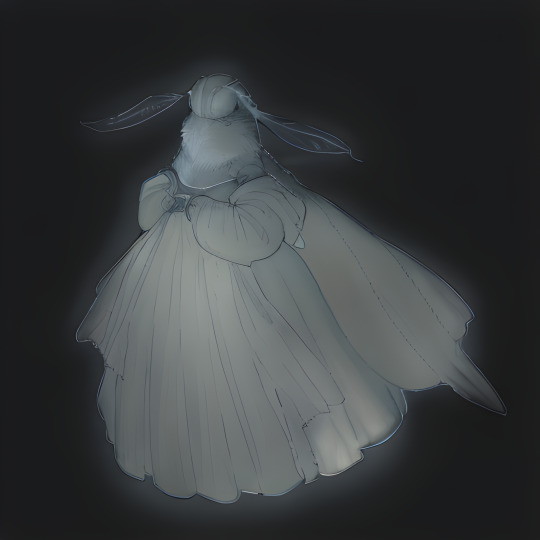
After touchup:
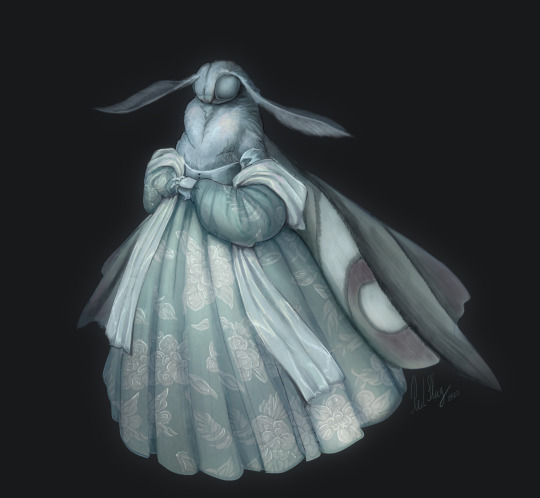
There was quite a bit of touchup on this first attempt with the generation serving mostly as a rough under drawing, but then again I didn't stress the network with details too much.
Then I tried squeezing more definition out of it.
Attempt 2:
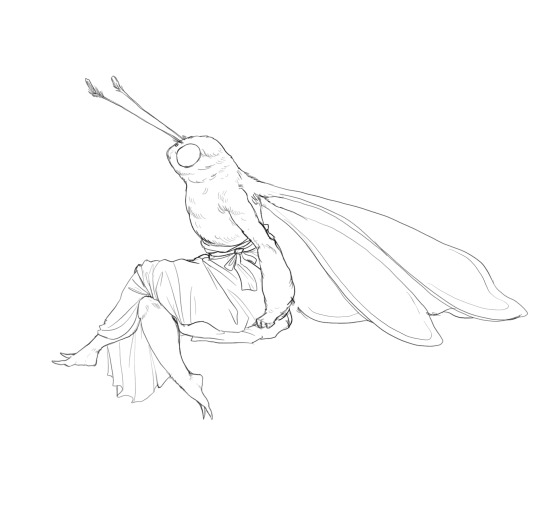
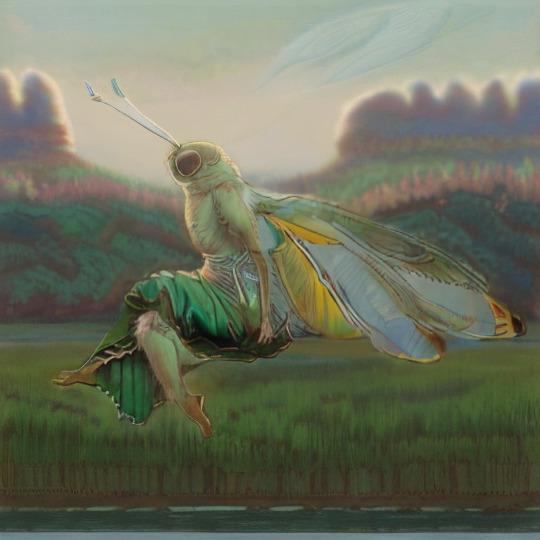
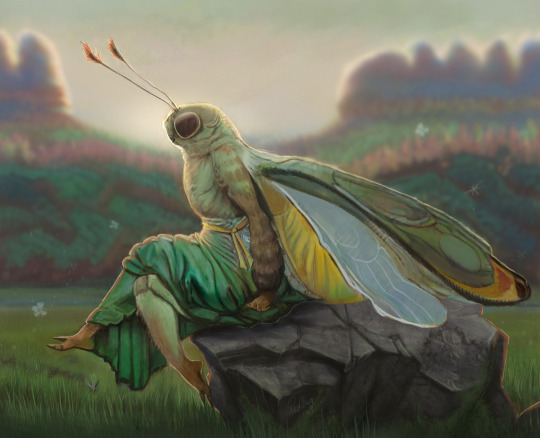
It can be quite competent when I supplement it with styles it knows well. I only used 30 of my own images to teach it, so it might be a little starved for examples at the moment. Adding "Bob Eggleton" seems to knock some sense into it for now.
Okay, still images are working, now let's bash Neuroslug against some animation.
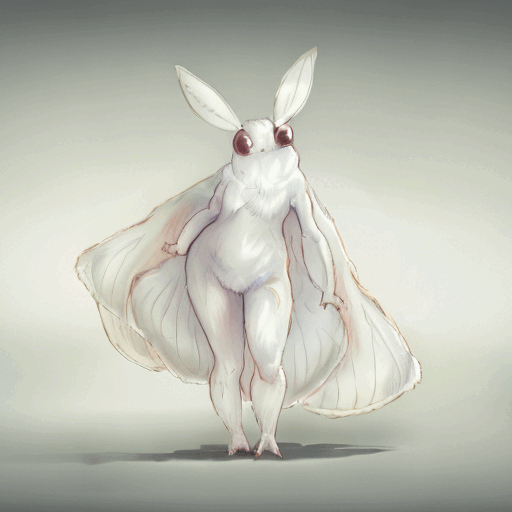
For something named Stable Diffusion it's not the most stable, huh. I'm still pleased with the result though, it's pretty cute. And while trying to make it cute I learned a little thing.
AI art isn't art. It's a mixture of alchemy, gambling, detective work and demon summoning it seems. And a bit of just art.
What I mean by that is that it can attach very unexpected meanings to words. Since I trained the AI on just anthro insects, it follows their defined anatomy quite closely. Specifically, they do not have breasts. As a result, adding "with big boobs" to the prompt changed the shading style and colors but not the actual anatomy.
And so, most of my prompts have this lovely phrase just to improve the colors.
'Kay, time for the freak show.
At some point during testing the machine decided that my moth isn't decent enough and put panties on her suddenly.
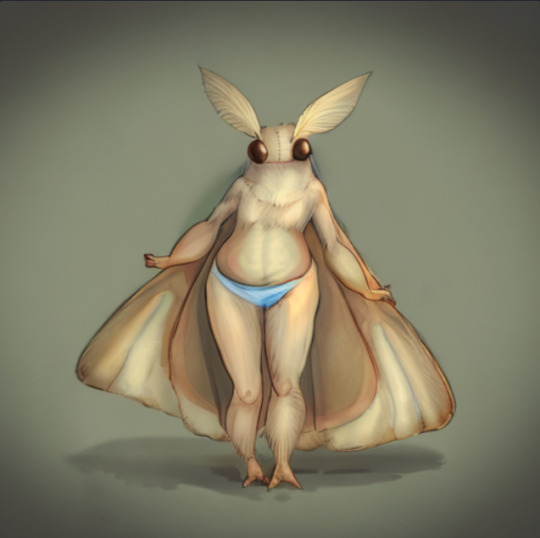

Now that's a booty

Look at those eyes

They have seen things
As you can probably tell these have no sketch to guide the result.

It's still bad but it's got the right spirit.

THICC

Surprisingly cute even if janky.
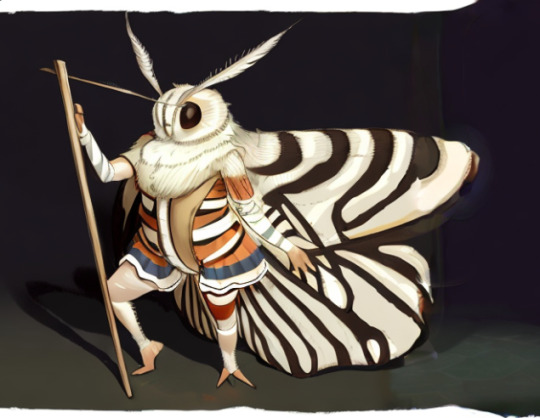
Looks better than it has any right to
Now I'll crawl back into my hole to play with settings for an indeterminate amount of time.
I'll publish my mini-me for you all to mess with once I deem it stable enough.
#slug's experiments#anthro#insect#moth#wooo i'm giddy#all the things I can do now#It's like i was gifted double length days to make stuff#with this i can make comics in painterly style that would be too time consuming otherwise
348 notes
·
View notes
Text
Bad at Sports Sunday Comics with Tara Booth
By Krystal DiFronzo
Tara Booth’s work is an assertive clash of color that depicts the most humbling and sticky situations. Some relatable moments include trying to pee while wearing a romper, cutting bangs into near oblivion, and stoned Amazon shopping (with the resulting surprise package hangover). My first introduction to Booth’s comics were through her Tumblr back in the golden age of cartoonists using that platform. Since then she’s had her work published by kuš! and Colorama. She regularly posts comics and in progress work on her Instagram @tarabooth.
Krystal DiFronzo: The first thing I noticed about your comics is the density of information, there’s so much color and pattern all piled on top of each other! Also you use gouache like a painter, not like a cartoonist coloring between lines. The ghost layers of paint create this constant atmospheric movement. The reader is made aware of the hand and medium, unlike traditional pen and ink comics. Do you have a background in painting prior to your comics? If so, why the transition to comics or are they all part of a single practice?
Tara Booth: I studied painting and graduated with a BFA at Tyler School of Art. I used to work on big 4×5 foot canvases that I built, stretched, gessoed, and sanded over and over. This time-consuming preparation, combined with the preciousness of the material gradually grated on me. I appreciate the importance of these processes and I’m happy to have access to this skill set, but it wasn’t something that I ever wanted to include in my everyday art practice (due to my extreme and often debilitating impulsivity). Producing work in art school wasn’t a problem for me, but I wasn’t a great student. It became increasingly difficult to connect to ideas being taught in my painting and art theory classes, which were focused more on abstraction and conceptualism than direct representation or narrative, which is where my interest had always been. The language and concepts we studied felt really inaccessible and detached from my experiences as a highly-dramatic, drunk 21-year-old. I started to focus more on folk art, Lowbrow, and self-taught artists. I began reading more comics, and decided I wanted to make paintings that were direct, accessible, and inexpensive to produce—so I transitioned to working on paper with gouache, with the ambition of eventually making my own comics.
KD: Your comics also have a lot of unusual formatting choices that affect how you read it. They don’t have any formal paneling or gutters, they flow across the page almost like an animation or a Muybridge study. You can read the comic either left to right or as a single-paged composition. They are also predominantly dialogue-less other than their titles. What made you come to these decisions? What’s your planning process like?
TB: The unusual formatting in my comics isn’t something that I had planned. For the longest time I felt really stunted by my background in traditional painting. I bought a bunch of comics, and attempted to mirror the techniques I saw, but working in panels always felt totally awkward. I had little experience with Photoshop, storytelling, principles of design… teaching myself how to make a comic felt like an uphill battle. Five years after graduation, I still hadn’t produced anything solid. I had kind of given up, and finally decided that making a shitty comic was better than not making anything at all—that I should worry less about what I think a comic is supposed to look like, and more on painting within the realm of my own abilities. Once I threw all of my preconceived notions out the window and forced myself to get to work, I actually started to get recognition for what I was doing rather quickly. Embracing some of my naivety and focusing on the painterly qualities in my work has compensated for whatever technical obstacles stood in my way. I still struggle with using text in my work. Until I’m more comfortable with my writing, I’m relying symbols, visual cues, facial expressions, and body language to tell my stories.
I like that you mention Muybridge studies, I look at them all the time. They’re one of my main influences. I love them!
KD: It’s a common trope of comics or animation that characters wear the same outfit. Like opening up a closet to rows of one identical dress. Your stand-in wears such incredible outfits in every comic, they almost become characters themselves. Do you have an interest in design? (Please make Fantomah leggings a reality.)
TB: Ha! I would love to work in textile design. In a failed attempt to simplify my life, I’ve ended up with a pretty boring wardrobe. I like to use my little avatar as a paper doll, dressing her up in outfits that I wish I owned myself. (Does anyone want to offer me a job?) I also use the clothing as a way to explore difference ways of drawing. To find different ways to use line, play around with abstraction and incorporate more surreal subject matter. I spend so much time working on this one body of work, I haven’t been prioritizing stylistic experimentation. It’s nice to have tiny t-shirt shaped opportunities to paint in ways that might feel separate from my comics practice.
KD: I’m emailing you while you’re at Printed Matter’s LA Book Fair, what was the show like for you? Could you talk about your new book with Colorama?
TB: The Art Book Fair was great! Like plenty of other artists I have a lot of anxiety in social situations, so it was stressful for me, but wow—so much of that melted away as the fair went on. It felt amazing to be surrounded by so many talented people, beautiful books, and all of the supporters who make this stuff possible. I was able to spy on a lot of my instragam art crushes. I loved watching how excited people were to buy my work. I got to see them laugh as they flipped through my prints, and I had some fun conversations. A few people even brought me gifts! But the most important and exciting part of the Art Book Fair was finally meeting my publisher, Johanna! She runs Colorama, a publishing house in Berlin. We’ve been communicating through email for months now, and it felt like the best blind date ever. The book she published for me, “D.U.I.I”. is the riso printed story of one of the most awful experiences I’ve had. It was also one of the most beneficial things that has ever happened to me. I got a DUII in February 2016. I’m an alcoholic, and this was the culmination of years of increasingly toxic behavior. Court ordered sobriety seems to be the motivation that I needed to change. I’m incredibly thankful that I didn’t hurt anyone. It’s a humiliating story to tell, but I felt a compulsion to draw it all out. I feel so lucky that Colorama decided to work on this project with me. It’s very different from my more popular, colorful work. I’m still dealing with the stressful and expensive results of that experience. Making the book was a huge part of the process of working through it. I tried to lighten it up a bit and make it silly—but yeah, its all true.
KD: Your work is true to life but veers into the surreal. It feels like it’s in the same vein as work by Julie Doucet, Gabrielle Bell, or Dori Seda. Artists who told confessional stories of humiliation and embarrassment but added fantastical elements for comedic or therapeutic effect. What about writing semi-autobiographical work interests you? Do you see yourself leaning more towards fiction or towards memoir?
TB: I’ve always been drawn to autobiographies, in comics and in literature. I really admire a lot of the artists you mention, and confessional work like theirs is part of what inspired me to make comics to begin with. For years I’ve kept a diary filled with drawings, but its tricky. Really putting yourself out there is scary. The paintings that I post publicly, while totally based on my daily life, are drastically different in tone and content than what you might find in my journals. My comics are embarrassing, funny, absurd, relatable… they can be sad, but I think it’s easy to see how I use humor and fantasy as a way of dodging some of the more raw and dangerous territory that can make autobiography so potent. I’m glad that my drawings make people laugh, I don’t want to take myself too seriously and I’ll always make silly drawings… I guess I just hope that as I continue to make comics, I’ll find a way to add more depth to my practice, whether it’s by working on developing more complex fictional stories, or by being brave enough to express some of the heavier, and maybe less palatable aspects of my life.
KD: Outside of comics, what artists or media makers are inspiring you right now?
TB: Well, first I’d like to say how incredibly inspired I am by artists like Marie Jacotey and Aidan Koch, whose work transcends the world of comics. I want the space between the comics world and the art world to keep getting smaller and smaller. These two stand out in my mind as artists that are helping to bridge that gap. I’d love to be a part of that transition. I’m always discovering new painters. Some of my favorites are Misaki Kawai, Austin Lee, Mogu Takahashi, Katherine Bernhardt (I’m inspired both by her paintings, and by the gorgeous Morrocan rugs that she sells) and Danny Fox. These people remind me of how powerful one large stand alone image can be. I follow the work of so many illustrators, but my favorites are probably Aart-jan Venema and Monika Forsberg, I’m always trying to figure how they do what they do. Who else… there’s a lot of really interesting stuff happening with ceramics that makes me want to get my hands on some clay. Benjamin Phillips is making great pots, it looks like it could be really fun to work in that style. Clay reminds me of Janie Korn, who makes really fun claymation shorts. Having access to all of these creative minds through social media sheds light on the infinite avenues that I want to explore in the future.
To order D.U.I.I, head to the COLORAMA webstore.
Dark Noise : An Interview with Chris Hammes
Half the sky, all your attention.
What We’re Doing This Weekend: 3.20-3.22
Endless Opportunities (Or Something)
MAINTENANCE #3
from Bad at Sports http://ift.tt/2mHQxB6
via IFTTT
0 notes